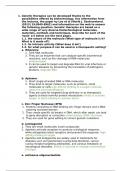US Congress
- Bicameral structure (made up of 2 chambers) = House of Representatives and Senate
- The House of Representatives would be directly elected with each state appointing a
number of representatives in line with its population. Would represent popular
sovereignty. Has the right to begin all appropriation bills
- The senate would be appointed by the state legislators, each state getting 2 senators.
The senate became an elected chamber following the 17th amendment in 1913. Each
senate would serve 6 years. Has the right to ratify treaties and appointments
- The both have shared powers (concurrent powers)
Membership of Congress
House of representatives:
- 435 voting congress men and women and 6 non-voting members
- 7 states only have 1 representative as there are less than a 1 million people. California
has the most members with 53 members for its population of nearly 40 million.
- Congressional districts (drawn by the state gov) are redrawn every 10 years.
- The whole house is up for elections every 2 years. There is no limit on the number of
terms that can be served (John Dingell served Michigan for 59 years until retiring in
2015)
- Speaker of the house, majority and minority leaders and whips
Senate:
- 100 senators with the vice president casting the deciding vote in the event of a tie
- 2 senators per state
- Every senator represents their whole state
- Each senator serves 6 years with ⅓rd of them up for election every 2 years. Known as
Class I,II,III
- No limit on the no. of terms you can sit. E.g. Robert Bryd served West Virginia for over
51 years until he died in 2010
Congressional elections
● Occur every 2 years. All federal government elections use the FPTP electoral system,
which helps to explain the 2 party system. In every election every seat in the House of
Representatives is up for election and ⅓rd of the senate seat. When congressional
elections take place in the middle of a presidential term they are known as midterm
elections
, ● If the government becomes divided midterm it can make it difficult for the president to
pass their legislative agenda. In 2016 the republican senate refused to allow
confirmation hearings for Obama’s Supreme Court nominee.
The significance of incumbency
- Incumbents in an election can hold significant advantages over their political
challengers.
- Incumbents have the ability to raise more money as they are well known. Therefore they
spend less in order to get people to vote for them.
- In 2020, Senate Republican Leader McConnell needed to spend on average $34 per
vote to retain his senate seat compared to $92 per vote for his Democratic challenger.
- Incumbents have some congressional advantages, they are provided with a website on
which they can explain their policy beliefs, demonstrate their policy successes and
failures, and offer an easy way for constituents to contact them.
- They also have franking privileges, meaning the cost of mailings to their constituents is
provided for by Congress.
- Boundaries of congressional districts also help to explain the high reelection rate of
incumbents. They are drawn within each state and the party controlling each state’s
legislature has the opportunity to redraw these boundaries every 10 years, This can lead
to gerrymandering. Where a state’s governing party draws the boundaries of each
constituency to give it an electoral advantage.
The distribution of powers within congress
Concurrent powers of Congress:
1. Create legislation: Ability to amend, delay and pass legislation. Congress can block,
amend or reject legislation proposed by the president. Biden put forward his Build Back
Better plan and his social security plan, 2 parts were held up in Congress. Congress’
refusal to pass legislation funding Trump's border wall led to the longest gov shutdown in
US history.
2. Override the president veto: Once a bill has been passed in Congress it requires a
signature from the President, however the president has the power to veto this bill.
Congress can overturn this veto if it reaches ⅔ rds vote in both houses. In 2020,
Congress overrode Trumps veto of the national defence authorization act with bipartisan
cooperation between republicans and democrats. 81 voted to override the veto. In
House 322 voted to override it.
3. Propose constitutional amendment: With ⅔ rds vote in both houses, Congress can
propose amendments. Representative Cohen proposed limiting the presidential power of
the pardon in the 117th Congress.
4. Declare war: Used on Romania in 1942. Congress tries to use the powers it has over
money and tax to control a president’s desire for military action.
- Bicameral structure (made up of 2 chambers) = House of Representatives and Senate
- The House of Representatives would be directly elected with each state appointing a
number of representatives in line with its population. Would represent popular
sovereignty. Has the right to begin all appropriation bills
- The senate would be appointed by the state legislators, each state getting 2 senators.
The senate became an elected chamber following the 17th amendment in 1913. Each
senate would serve 6 years. Has the right to ratify treaties and appointments
- The both have shared powers (concurrent powers)
Membership of Congress
House of representatives:
- 435 voting congress men and women and 6 non-voting members
- 7 states only have 1 representative as there are less than a 1 million people. California
has the most members with 53 members for its population of nearly 40 million.
- Congressional districts (drawn by the state gov) are redrawn every 10 years.
- The whole house is up for elections every 2 years. There is no limit on the number of
terms that can be served (John Dingell served Michigan for 59 years until retiring in
2015)
- Speaker of the house, majority and minority leaders and whips
Senate:
- 100 senators with the vice president casting the deciding vote in the event of a tie
- 2 senators per state
- Every senator represents their whole state
- Each senator serves 6 years with ⅓rd of them up for election every 2 years. Known as
Class I,II,III
- No limit on the no. of terms you can sit. E.g. Robert Bryd served West Virginia for over
51 years until he died in 2010
Congressional elections
● Occur every 2 years. All federal government elections use the FPTP electoral system,
which helps to explain the 2 party system. In every election every seat in the House of
Representatives is up for election and ⅓rd of the senate seat. When congressional
elections take place in the middle of a presidential term they are known as midterm
elections
, ● If the government becomes divided midterm it can make it difficult for the president to
pass their legislative agenda. In 2016 the republican senate refused to allow
confirmation hearings for Obama’s Supreme Court nominee.
The significance of incumbency
- Incumbents in an election can hold significant advantages over their political
challengers.
- Incumbents have the ability to raise more money as they are well known. Therefore they
spend less in order to get people to vote for them.
- In 2020, Senate Republican Leader McConnell needed to spend on average $34 per
vote to retain his senate seat compared to $92 per vote for his Democratic challenger.
- Incumbents have some congressional advantages, they are provided with a website on
which they can explain their policy beliefs, demonstrate their policy successes and
failures, and offer an easy way for constituents to contact them.
- They also have franking privileges, meaning the cost of mailings to their constituents is
provided for by Congress.
- Boundaries of congressional districts also help to explain the high reelection rate of
incumbents. They are drawn within each state and the party controlling each state’s
legislature has the opportunity to redraw these boundaries every 10 years, This can lead
to gerrymandering. Where a state’s governing party draws the boundaries of each
constituency to give it an electoral advantage.
The distribution of powers within congress
Concurrent powers of Congress:
1. Create legislation: Ability to amend, delay and pass legislation. Congress can block,
amend or reject legislation proposed by the president. Biden put forward his Build Back
Better plan and his social security plan, 2 parts were held up in Congress. Congress’
refusal to pass legislation funding Trump's border wall led to the longest gov shutdown in
US history.
2. Override the president veto: Once a bill has been passed in Congress it requires a
signature from the President, however the president has the power to veto this bill.
Congress can overturn this veto if it reaches ⅔ rds vote in both houses. In 2020,
Congress overrode Trumps veto of the national defence authorization act with bipartisan
cooperation between republicans and democrats. 81 voted to override the veto. In
House 322 voted to override it.
3. Propose constitutional amendment: With ⅔ rds vote in both houses, Congress can
propose amendments. Representative Cohen proposed limiting the presidential power of
the pardon in the 117th Congress.
4. Declare war: Used on Romania in 1942. Congress tries to use the powers it has over
money and tax to control a president’s desire for military action.






